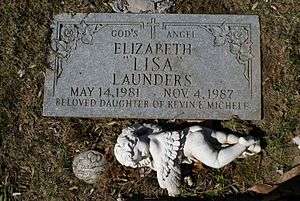Joel Steinberg
Joel Steinberg (born May 25, 1941), a disbarred New York criminal defense attorney, attracted international media attention when he was accused of murder and convicted of manslaughter in the November 1, 1987, death of a six-year-old girl, Elizabeth ("Lisa"), whom he and his live-in partner Hedda Nussbaum had illegally adopted. Steinberg had reportedly been hired by a single mother to locate a suitable adoptive family for Lisa, but instead took the child home and raised her with Nussbaum, never filing formal adoption papers and therefore never being scrutinized as adoptive parents.
Early life
Joel Steinberg was raised in the Bronx and Yonkers.[1] In 1962 he graduated from Fordham University.[1] After graduation, Steinberg attended law school but dropped out in 1964 and joined the US Air Force in 1965.[1] Following his military career he finished law school and was admitted to the New York State Bar Association without being required to take the bar exam through a special program for military veterans.[1][2]
Crime and punishment
Steinberg was specifically accused of hitting Lisa on the head and then not seeking medical attention for the child, supposedly because he was under the influence of crack cocaine. She died at Saint Vincent's Hospital after being removed from life support on November 4, 1987 three days later after being transported from the apartment in New York's Greenwich Village that Steinberg shared with Lisa, Mitchell (a younger child also illegally adopted by Steinberg, 18 months old at the time of Lisa's death), and Steinberg's partner Hedda Nussbaum. Both the boy and Nussbaum showed signs of physical abuse, and Nussbaum's battered, unkempt appearance did much to fuel the media frenzy that accompanied the story of Lisa's death.
In exchange for her testimony against Steinberg, Nussbaum was not prosecuted for events related to Lisa's death. Nussbaum was alone in the apartment with an unconscious and bleeding Lisa for over ten hours without seeking any medical attention for the girl. At Steinberg's trial, his defense suggested that Nussbaum's extensive injuries, which included severe damage to the face and permanent spinal damage, resulted from a consensual sadomasochistic relationship between the two. Her attorneys claimed her remaining with him when he beat her was a sign of battered woman syndrome.
In New York State at that time, first degree murder applied only to those who killed police officers or had committed murder while already serving a sentence for a previous murder. Unable to convict Steinberg on the more serious charge of second-degree murder, the jury convicted him of the next most serious charge, first-degree manslaughter. Judge Harold Rothwax then sentenced him to the maximum penalty then available for that charge — 8 1⁄3 to 25 years in state-prison.

On two occasions, Steinberg was denied discretionary parole, mainly because he never expressed remorse for the killing. However, on June 30, 2004, he was paroled under the state's "good time" law, which mandates release of inmates who exhibit good behavior while incarcerated after having served two-thirds or more of the maximum possible sentence. New York State has since increased this ratio to six-sevenths of the maximum term for persons convicted of violent felonies. Steinberg had spent most of his imprisonment at New York State's "Supermax" prison, the Southport Correctional Facility, presumably to prevent him from being attacked by other inmates.
After his release, Steinberg moved to Harlem, where he took up work in the construction industry. As of 2006, he continued to maintain his innocence.[3]
Meanwhile, the other child in the case ended up being reunited with his biological mother, Nicole Bridget Smigiel.
Lawsuit
On January 16, 2007, the New York Supreme Court, Appellate Division (New York's intermediate appellate court) upheld a $15 million award against Steinberg to Michele Launders, Lisa's birth mother. In its opinion,[4] the court rejected the position that Steinberg, acting as his own attorney, put forth:
- [F]or Steinberg to dismiss the 8 to 10 hours preceding Lisa's death as "at most eight hours of pain and suffering" or as he alternatively states, a "quick loss of consciousness" (emphasis supplied), demonstrates that he is as devoid of any empathy or human emotion now as he was almost 20 years ago when he stood trial for Lisa's homicide. As any parent and, no doubt, most adults who have taken trips with young children can attest, the oft-heard question, "are we there yet?" is a clear illustration that, the more anticipated an event or destination so, seemingly slower the passage of time in a child's mind. For Lisa, lying on a bathroom floor, her body aching from bruises of "varying ages," her brain swelling from her father's "staggering blow," those 8 to 10 hours so cavalierly dismissed by Steinberg must have seemed like eternity as she waited and wondered when someone would come to comfort her and help make the pain go away.[4]
References
- 1 2 3 4 Gado, Mark. "The Killing of Lisa". TruTV. Archived from the original on January 9, 2014. Retrieved April 15, 2015.
- ↑ Gado, Mark. "All about Lisa Steinberg — "A Child Not Breathing" — Crime Library on". Trutv.com. Retrieved 2014-01-23.
- ↑ "The Monster Now," The New York Daily News, July 10, 2006
- 1 2 Launders v. Steinberg, 2007 NY Slip Op 00246 (Jan. 16, 2007 N.Y. App. Div).
Further reading
- Johnson, Joyce (1 April 1991). What Lisa knew: the truths and lies of the Steinberg case. Kensington Pub. Corp. ISBN 978-0-8217-3387-5. Retrieved 10 September 2011.